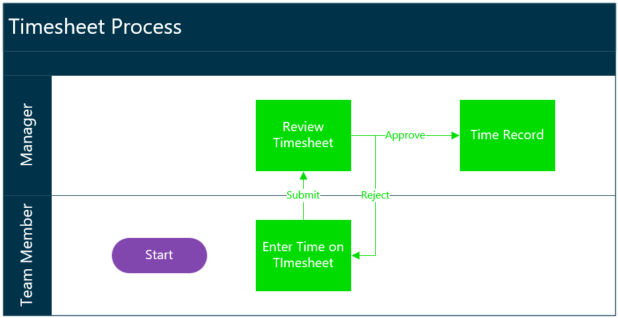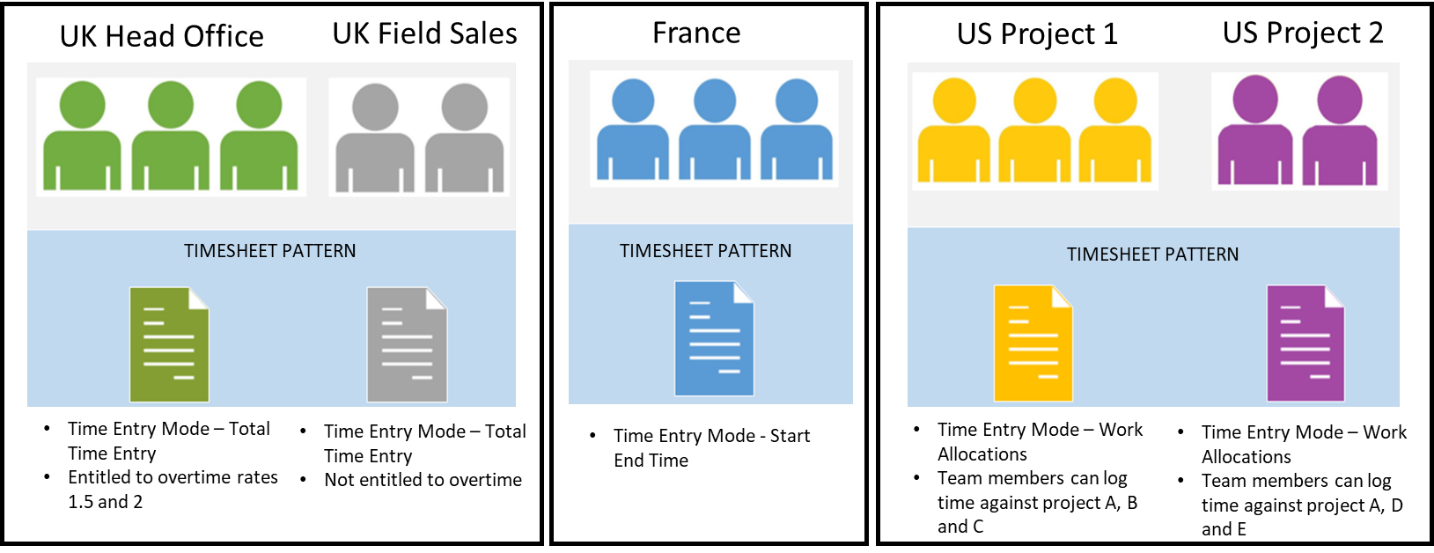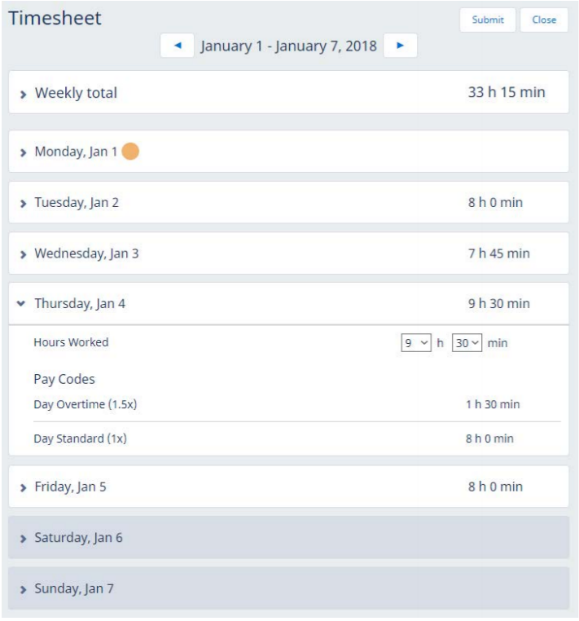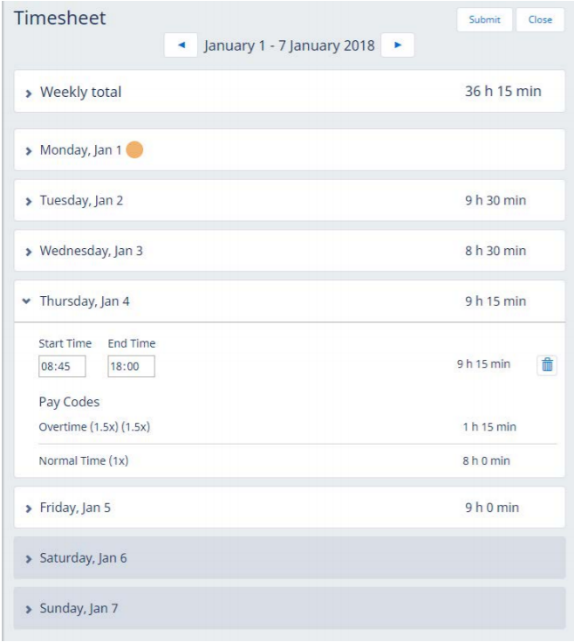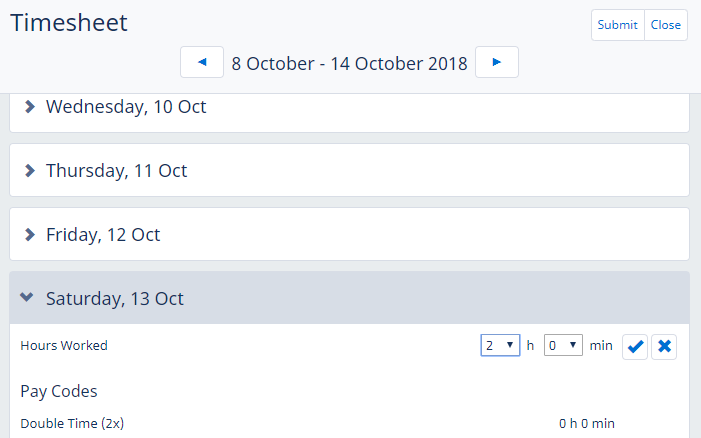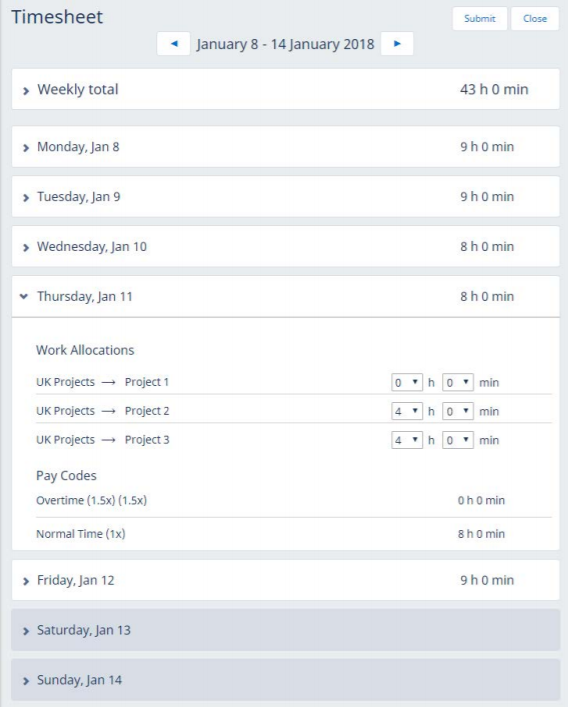Timesheets | Business context
Overview
Sage People enables you to manage timesheet-based attendance.
Timesheets are useful when your organization calculates pay based on the time worked for at least some of your employees. You can also use them when you want to track hours worked against specific projects or customers.
Timesheets in Sage People offer:
-
Time reporting through Sage People WX using one of the following time entry modes:
-
Total time: Employees enter the total hours worked each day. Sage People automatically calculates pay rates and overtime.
-
Start and end time: Employees enter start and end times for hours worked. For example, if the lunch is paid time, employees enter a time period. Or if lunch breaks are unpaid, the employees enter start and end times for each working period.
-
Pay code: Employees enter hours for each pay rate, such as double time or time-and-a-half rather than having Sage People calculate them. Organizations typically use this entry mode when employees only log the time in exception to normal hours.
-
Work allocation: Employees enter hours against specific tasks, projects, or customers. You cannot use the work allocations entry type with the start and end time entry type.
-
-
Timesheet pattern management enables groups of employees to have defined time reporting requirements, overtime rules, and overtime conditions. Timesheet patterns can apply to policies or to individual team members using an override on the Employment Record.
-
Team member timesheet data can be used to calculate pay and the amounts of billable time. The calculations are based on specified pay codes and overtime rates.
-
You can configure a link to payroll through Sage People Payflow using timesheet data.
- You can integrate timesheets with work schedules.
The following diagram displays the Timesheet process to team members and managers:
How customers use timesheets
For more information about how team members and managers use the Timesheet process, see the following help center topics:
-
Team members: Entering time worked
-
Managers: Approving Timesheets
How many timesheet patterns does an organization need?
The number of timesheet patterns an organization needs depends on several factors:
-
If you manage in the same way across your organization, you probably only need one timesheet pattern
-
If different employees use different time entry modes, have different overtime rules, or use different work allocations, you probably need more timesheet patterns.
The most common groupings are geographical or departmental. For example, where one group in a department has paid overtime entitlement and another does not.
Consider the following factors when determining how many timesheet patterns you need:
- Time entry mode: Do different groups of employees have different time entry modes? Each timesheet pattern can use only one time entry mode.
- Pay codes and overtime conditions: Do different groups of employees have different entitlements to overtime? If the overtime rates and conditions for when employees can earn overtime vary, you probably need multiple timesheets patterns.
- Work allocations: Do different groups of employees have different work allocations? If you want to assign specific work allocations to a timesheet pattern, you probably need multiple timesheets patterns.
- Time steps: Do different groups of employees use different increments for timesheet entry? If yes, you need multiple timesheet patterns.
- Time span: Do different groups of employees complete timesheets for different time periods? For example, do you have some employees on weekly timesheets and others on monthly? If yes, you need timesheet patterns for the different time spans.
When you consider these factors, you only need one timesheet pattern if all are identical across your employee groups. If any of the factors differ, you need multiple timesheet patterns to accommodate the variations.
The following example illustrates these considerations:
An organization has employees in three countries: France, UK, and USA. The organization considered the following points when creating their timesheet patterns:
- Time entry mode: Each country requires a different time mode entry
- Overtime: In the UK, one group has overtime entitlement and another group does not
- Work allocations: In the USA, two teams use work allocations for projects, and each team have their own projects
The following diagram illustrates the need for five timesheet patterns based on the assessment:
Time entry modes
Depending on how you want your team members to log time, you can configure Sage People timesheets to use different entry modes as follows:
Total time entry mode
The team member enters the total hours worked against each day. Sage People calculates pay rates and overtime. Each day displays an Hours Worked field for time entry. Using the overtime rules and overtime conditions associated with the timesheet pattern, Sage People allocates the time to standard and overtime. Sage People uses the work days pattern to define the work week and flag public holidays. It also applies time worked on non-work days to the pay codes defined by overtime conditions.
Start-End time entry mode
The team member enters the start time and end time for each time period against each day. Sage People calculates pay rates and overtime. Using the overtime rules and overtime conditions associated with the timesheet pattern, Sage People allocates the time to standard and overtime.
Each day has Start Time and End Time fields for each defined time period during the working day. This mode typically applies to shift working. You can define the period start and end time to the nearest minute. You can constraint entries to defined step time increments. For example:
-
Employees enter time in quarter-hour increments, so the step time is 15 minutes
-
Employees enter time in tenths of an hour, so the step time is 6 minutes
Sage People can then use overtime conditions automatically to allocate time worked to each pay code.
Pay code time entry mode
Team members enter their hours worked against pay codes for each day, instead of the system calculating pay rates and overtime automatically
Each day displays fields for time entry for each pay code, such as Normal Time (1x) or Overtime (1.5x). Sage People uses the work days pattern to define the work week and flag public holidays. It also displays the appropriate Pay Code fields for time entry on non-work days, typically representing some form of overtime. Sage People calculates the total hours worked and hours worked for each pay code. Organizations typically use this mode when only overtime needs to be recorded, rather than standard working hours.
Work allocation time entry mode
Team members enter their hours worked against work allocations. You can add work allocations for specific tasks, projects, or customers. Sage People calculates pay rates and overtime. This method is typically used for employees who work on different projects. Using the overtime rules and overtime conditions associated with the timesheet pattern, Sage People allocates the time to standard and overtime.
By default, the Work Allocation object has the following fields:
- Area: The top level of the hierarchy, such as a geographical area or an area of expertise. You can rename the field to something more meaningful to your organization. For example, to match with the Org Unit fields used on the Employment Record.
- Work Allocation Name: The second level of the hierarchy, such as a customer name, product line, a major project name. You cannot rename this field because it’s used in back-end processes.
-
Code: The third level of the hierarchy, such as a customer project, a sub project, or a team name. You can rename the field to something more meaningful to your organization.
If required, you can create extra levels of hierarchy to work allocations.
Timesheet approval
When a team member submits their timesheet, it goes to their manager for approval.
Features and assumptions
Features
| Organizational group | Advantages |
|---|---|
| Team members |
Have visibility to current and previous timesheets whenever needed on WX |
| HR |
|
| Managers |
|
Assumptions
- One of the available time entry methods meets the organization’s needs
- Work allocation can only be used with total time entry. It's not possible to combine the Start-End time entry mode and work allocations.
- The default line manager approval of timesheets is sufficient
Customer input
When implementing timesheets, the following input is needed:
-
What timesheet period do you use?
- Weekly
- Bi-weekly
- Semi-Monthly
- Monthly
-
Which time entry modes will you use?
- Total time entry
- Start-End time entry
- Time entry by pay code
- Time entry by work allocation
-
What rates of pay (Pay Codes) do you use?
- Normal
- Time and a Half
- Double Time
- Other
- Which conditions affect the rate of pay or overtime conditions?
- If you use work allocations, describe them.
- If you use Start-End Time mode, how many periods are in a day?
- How many minutes are in each time step?
-
Who needs to see overtime calculations?
-
HR only
-
HR and manager
-
Team member, manager, and HR
-
- Do users need to be able to enter comments on each day?
- Do users need to be able to enter comments on each time period?
